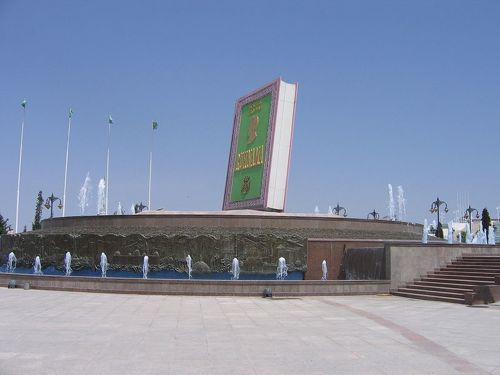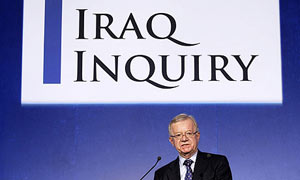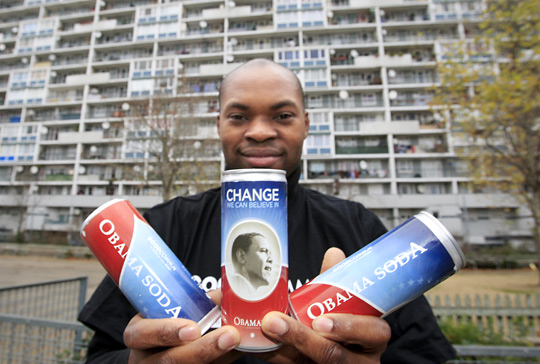
By Huang Qingjun, click for more
The inexhaustible Junk Culture:
Huang Qingjun and Ma Hongjie … project ‘Family Stuff’ [aims] to portray rural Chinese families and their possessions …. A series of 20 images has been compiled that were exhibited at the 798 Photo Gallery in Beijing in 2007… . In 2011 the project is scheduled to end with a total of 50 pictures and a book.
This post is part of an occasional
series.
Posted Under:
Artists,
World News
This post was written by Rob Walker on May 10, 2010
Comments Off on Pictures of Stuff, cont’d: Chinese families and their possessions

Mr. Portigal (thanks!) points out this Metafilter post that I’d missed:
In the capital of Turkmenistan stands an enormous statue of a book. Every evening at 8PM, the statue swings open and a recently deceased dictator’s magnum opus, the Ruhnama, is broadcast throughout the square while a video from within the statue shows his image.
The post links to a documentary maybe by Finnish filmmakers and available on YouTube in 10 parts. I did not watch the whole thing. In this part, however, at about the 4:35 mark, there’s some twilight / nighttime footage of the book swinging open. I know precisely zero about the rather dodgy-sounding politics here, but an immense book that swings open, onto which video images are projected, is fascinating.

Click to see YouTube video; I’ve punched up this image a little.
This post is part of a series.
I don’t know how closely you’re following the inquiry over in Great Britain about that country’s decision to involve itself in the Iraq war. And I don’t have much to say about that.
But hey, how about the logo! What do you think of the type treatment? Is this going to make the Iraq Inquiry the breakout inquiry of 2010?



I was reading an article yesterday about Chinese manufacturers targeting domestic (vs. U.S. and European) consumers, and the main example was a bicycle maker. One of its challenges, the article noted, is that “big companies like Giant Manufacturing Co. of Taiwan already have a strong presence in the high end of the domestic bicycle market.”
How awesome is it that there is actually a company called Giant Manufacturing Co.?
That’s like something on The Simpsons.
They should make T-shirts.
Posted Under:
World News
This post was written by Rob Walker on September 30, 2009
Comments Off on Dept. of Impressive Corporate Names
In reading various articles about the alarming increase in the power and violence of the big Mexican drug cartels, I’ve noticed that while it’s always explained that said cartels have used their escalating profits in recent years to stock up on a dizzying array of weapons (often bought in the U.S. etc.)
What I haven’t seen is how their profits are holding up over the past six months or so. Is the downturn affecting demand for illegal drugs? One way or the other the answer would be interesting. Has that been written about and I just missed it?
 A story in the WSJ yesterday explained that Unilever’s famous “Campaign For Real Beauty” for its Dove products wasn’t working in China, where “women aren’t so bothered by the stunning models used in most beauty ads and aren’t driven to buy products promoted with so-called real faces.” Apparently the multinational has found what it hopes is a solution, by way of “Ugly Betty.” No, they aren’t simply sponsoring the Chinese version of the show — they’ve worked out a deal to basically produce a Chinese version of the show:
A story in the WSJ yesterday explained that Unilever’s famous “Campaign For Real Beauty” for its Dove products wasn’t working in China, where “women aren’t so bothered by the stunning models used in most beauty ads and aren’t driven to buy products promoted with so-called real faces.” Apparently the multinational has found what it hopes is a solution, by way of “Ugly Betty.” No, they aren’t simply sponsoring the Chinese version of the show — they’ve worked out a deal to basically produce a Chinese version of the show:
In an unusual move, Unilever’s ad-time-buying agency, WPP Group PLC’s Mindshare, brokered a deal to bring the format to Chinese TV, giving Unilever the right to exclusive ads and product placements during the show, as well as a script built around the company’s Chinese reformulation of the campaign for real beauty. …
On “Ugly Wudi,” protagonist Lin Wudi, who works at an ad agency, learns to unveil her own beauty, using Dove products and working on an imaginary ad campaign for the brand. …
In one episode, an actor playing the media director for Dove in China explains that an ad campaign that Wudi helped create epitomizes Dove’s view on beauty. “There are so many kinds of women and so many kinds of beauty,” he says. “This is exactly the message that Dove tries to put forth.”

Obama Soda, available in France — proof that the French really do know the meaning of the word entrepreneur (as the old joke goes). NPR story here.

At Selfridges. Via The Dieline.
Posted Under:
Products,
World News
This post was written by Rob Walker on October 13, 2008
Comments Off on Current-events product: “Credit Crunch” chocolates
From The Economist:
The term “emerging markets” dates back to 1981, recalls the man who invented it, Antoine van Agtmael. He was trying to start a “Third-World Equity Fund” to invest in developing-country shares, but his efforts to attract money were being constantly rebuffed.
“Racking my brain, at last I came up with a term that sounded more positive and invigorating: emerging markets. ‘Third world’ suggested stagnation; ‘emerging markets’ suggested progress, uplift and dynamism.”
 WORKER SOLE
WORKER SOLE
A simple shoe for Chinese laborers gets made over for Western consumers
This week in Consumed, a new addition to the centuries-old effort to communicate between East and West. Curiously, it’s a consumer product:
Ospop sneakers. Yes, they’re made in China by Chinese workers. But more unusually, and more to the point, they are inspired by Chinese workers. Specifically, Ospop sneakers are based on a design widely worn by such laborers, but with higher-quality materials and structural improvements meant to appeal to a Western audience — one that is, not incidentally, willing to pay $75 for a pair of sneakers.
Read the column in the August 17, 2008, issue of The New York Times Magazine, or here.
Consumed archive is here, and FAQ is here. Consumed Facebook page is here.
On occasion I’ve wondered why it is that “public service”-style marketing campaigns often seem so much less effective, less potent, than marketing campaigns on behalf of a product or service.
With that in mind I was interested in this article in the Times business section yesterday by Charle Duhigg. It’s about a public-interest organization focused on disease prevention in developing nations, teaming up with multinational consumer-products corporations with track records of “creating habits” via marketing.
(This is actually somewhat related to a June 10, 2007 Consumed on Unilever’s sales of Lifebuoy soap in parts of India.)
To make the point that such firms have a habit-creation record, Duhigg recounts the rise of Febreze, and its evolution into something that people basically spray in perfectly clean rooms, because they’ve acquired the (previously non-existent habit). A Procter & Gamble psychologist comments:
“For most of our history, we’ve sold newer and better products for habits that already existed. … But about a decade ago, we realized we needed to create new products. So we began thinking about how to create habits for products that had never existed before.”
Wow! You won’t hear a blunt description of demand-creation than that anytime soon!
Anyway, I digress, but the Febreze anecdote alone makes the article worth reading.
Back to the point. The piece explains how the role of advertising/marketing has in effect created good habits (hand washing, which greatly cuts down on the spread of certain ailments) via marketing that happens to yoke those habits to a product (soap).
So this brings me back to my curiosity expressed above. Are these companies just that much better at the persuasion process? Or, given that agencies/etc. who execute their campaigns also do plenty of traditional public service stuff, is it that there’s something about introducing the profit motive that affects the approach and increases the effectiveness? Is there some intrinsically more compelling about a “good habit” when it’s tied to a consumer good? Is it simply a matter of scale — ie, these consumer-goods firms have the budget to blow out a message in a far bigger way?
BusinessWeek‘s Michael Mandel has written several pieces highly pessimistic about consumer resilience. This week he assesses retail sales data, up 1.3% in the first quarter even after gas stations and fuel dealers are removed from the figures. (Earlier Murketing post musing on this topic here.) “Nothing,” he writes, seems to stop the U.S. consumer from spending.”
Then he makes an interesting point, something I didn’t know: Online sales from U.S.-based e-commerce sites made to foreign consumers count as part of U.S. retail sales.”
How big a deal is this? Well, e-commerce sales accounted for “roughly 36% of the increase in nonenergy retail sales” in Q1, he says. But there is apparently no data on how much of that came from abroad. Mandel offers anecdotal evidence from Blue Nile, an online jewelry seller: its sales are up 3.8% over last year and “all of that gain came from Internet sales customers outside the U.S.”
I doubt there’s enough of this sort of thing going on to cause a significant difference in overall retail sales, not enough at least to explain why consumer spending hasn’t collapsed — not yet at least — to the degree Mandel’s earlier writings have suggested they will. But he makes a good point: It would be better to have the details on this information, especially given that a weak dollar and other factors are likely to increase overseas sales.
 Almighty Dolor:
Almighty Dolor:
As Americans, we like the greenback, but as investors, we’re a little more willing to go where the money is
This week Consumed looks at spending money — on other forms of money.
Currency prestige has a long history in the context of nation-states, but the idea that individuals might find some forms of money more desirable than others is less familiar. Perhaps rising awareness of the falling dollar is changing that.
There is a way to, in effect, spend your dollars on other forms of money, and apparently the number of people doing so is increasing. …
Read the column in the May 11, 2008, issue of The New York Times Magazine, or here.
Consumed archive is here, and FAQ is here. Consumed Facebook page is here.
 So, see that giant representation of a beer bottle? That’s a coffin. Apparently.
So, see that giant representation of a beer bottle? That’s a coffin. Apparently.
Or maybe this is a hoax of some kind.
Either way, Delicious Ghost points to this Ghanaweb writeup, with more pictures: “The Ga people [of Ghana] believe that when their loved ones die, they move on into another life — and the Ga make sure they do so in style. They honor their dead with brightly colored coffins that celebrate the way they lived.”
Other branded examples include a giant Coke bottle, and an Air Jordan coffin.

[ –> Details on Sponsored-Film Virtual Festival are here.]
This 19-minute film, “Why Braceros?,” was produced in around 1959 on behalf of the Council of California Growers. It aims to tell viewers about “the benefits of the bracero program,” The Field Guide to Sponsored Films explains, “originally initiated by the United States in 1942 to alleviate the World War II labor shortage.” This was a “guest worker” program that made it okay for Mexican labor to be brought in seasonally to work on cotton farms and other manual jobs (“stoop labor,” it’s called in the films).
Anyway, the film carefully explains that these are really bad jobs, so they’re hard to fill. The issues are familiar: Even in the pre-Lou Dobbs era, people were angry that these supposedly job-threatening outsiders are allowed. Read more




 "
"









 WORKER SOLE
WORKER SOLE













 Kim Fellner's book
Kim Fellner's book  A
A